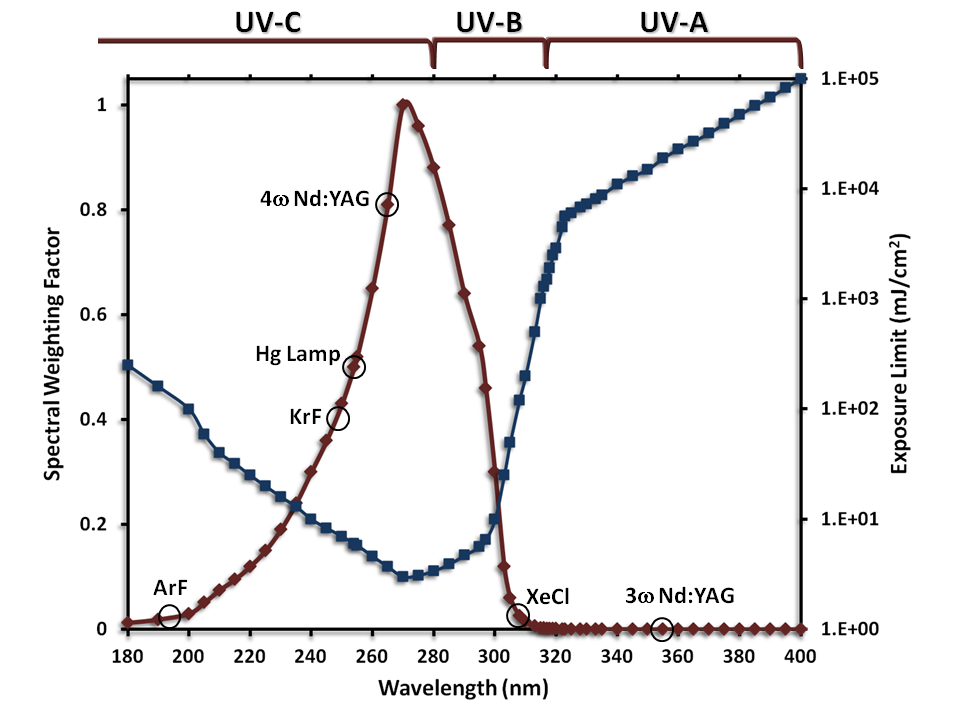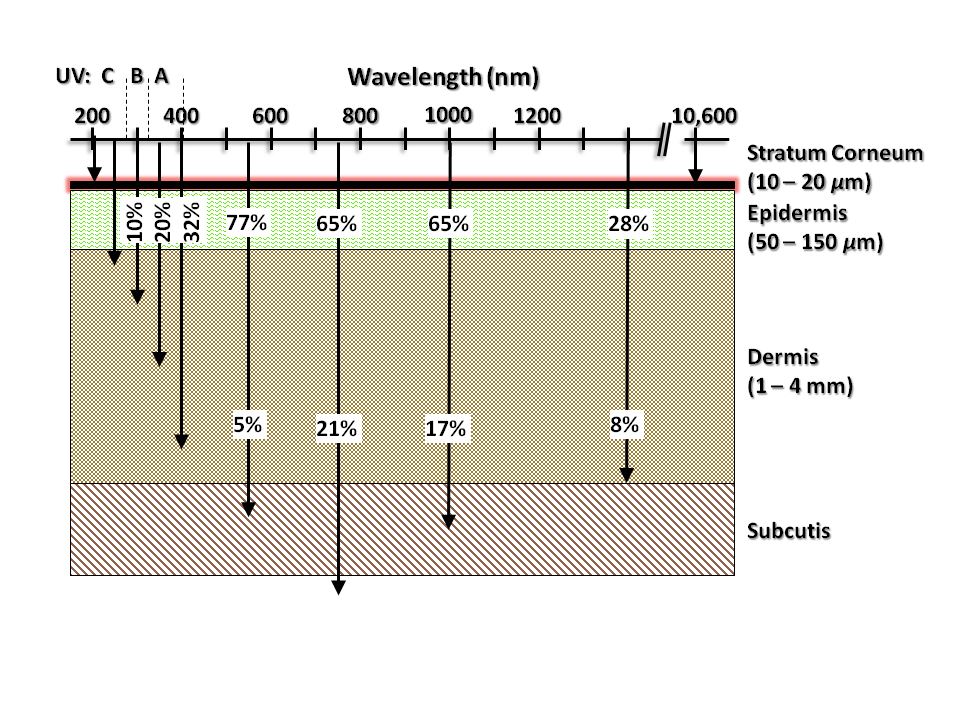UV radiation has many benefits: vitamin D production, sterilization (wastewater treatment and laboratory surfaces), and spectrometry. UV radiation is a hazard, though, and there are defined human exposure limits.
UV radiation exposure
These pages are dedicated to the risk awareness of UV radiation exposure and control measures used to minimize your exposure. Common applications on campus are also provided.
Overview

UV radiation
Many Canadian, American and International organizations have written extensively on natural sources of ultraviolet radiation and the effects of ultraviolet radiation on the skin and eyes. References to these sources are provided on the Reference page linked below.
Damage from photochemical reactions takes time to present itself: an individual may be exposed for the entire ‘work day’ before symptoms start to arise without stimulating an aversion response. Exposure limits for UV radiation are set as a total dosage (J m-2), similar to dosage limits with radiation exposure (X-Ray; alpha, beta, and gamma particles). UV exposure limits are set in an 8 hour time frame, though the onset time of symptoms can change depending on how much the exposure exceeds the threshold [1, p.106]. These thresholds, called Threshold Limit Values (TLVs), are set by the American Conference of Governmental Industrial Hygienists [2].
The exposure limits for UV radiation vary with wavelength (blue line in figure), since our tissue responds differently with wavelength (red line) [3]. The UV-B and UV-C bands have the highest activity in our tissue, while the UV-A has the least. Exposure to about 10 mJ/cm2 of UV-A radiation (ex: 355 nm) on the skin would not show any effect, while significant effects would be observed from the same dosage (radiant exposure) in the UV-C band (ex: 266 nm).
Figure: The Spectral Weighting Factor (red line) is a multiplicative factor that weights the effect of UV radiation for each wavelength. The Exposure Limit (blue) is smallest at the peak of the Weighting Factor (270 nm in the UV-C band) because our tissue responds the most at this wavelength [3]. Other than the mercury lamp (Hg lamp), all sources highlighted here are common laser wavelengths.

The exposure dose limit during a work day is 3 mJ/cm2 for actinic UV radiation (200 nm - 315 nm) based on the ACGIH TLV booklet [2]. The actinic region of the UV spectrum is the region of highest spectral sensitivity as shown in the red curve above. The actinic region contains some of the UV-C and most of the UV-B band. The total dosage in this spectral band translates into different effective irradiances of sources depending on the exposure duration, as shown in the following table.
| Exposure duration | Effective Irradiance (µW/cm2) |
|---|---|
| 8 hours | 0.1 |
| 4 hours | 0.2 |
| 2 hours | 0.4 |
| 1 hour | 0.8 |
| 30 minutes | 1.7 |
| 15 min. | 3.3 |
| 10 min. | 5 |
| 5 min. | 10 |
| 1 min. | 50 |
| 30 seconds | 100 |
| 10 s | 300 |
| 1 s | 3000 |
| 0.5 s | 6000 |
| 0.1 s | 30,000 |
Note that many drugs can modify an individual's sensitivity to UV and lead to over-exposure at dosage levels lower than that reported here.
References
[1] R. Henderson, K. Schulmeister, Laser Safety. Bristol, UK: IoP Publishing, 2004
[2] American Conference of Governmental Industrial Hygienists. (Accessed 2013, May 23). Ultraviolet Radiation: TLV® Physical Agents 7th Edition Documentation.
[3] International Commission on Illumination. (Accessed 2013, May 23). Erythema Reference Action Spectrum and Standard Erythema Dose.
References
[1] WHO. Ultraviolet radiation and human health [No longer online]
[2] WHO. Global Solar UV Index - A Practical Guide [Online]. Available: https://www.who.int/publications/i/item/9241590076
[3] Canadian Centre for Occupational Health and Safety. (Accessed 2013, May 23). Ultraviolet Radiation : OSH Answers [Online]. Available: www.ccohs.ca/oshanswers/phys_agents/ ultravioletradiation.html
[4] Health Physics Society. (Accessed 2013, May 23). Ultraviolet Radiation [Online]. Available:www.hps.org/hpspublications/articles/uv.html
[5] R. Henderson, K. Schulmeister, Laser Safety. Bristol, UK: IoP Publishing, 2004
[6] American Conference of Governmental Industrial Hygienists. (Accessed 2013, May 23). Ultraviolet Radiation: TLV® Physical Agents 7th Edition Documentation.
[7] International Commission on Illumination. (Accessed 2013, May 23). Erythema Reference Action Spectrum and Standard Erythema Dose
[8] General Electric. (Accessed 2013, March 13). 11078 – Specifications – GE Commercial Lighting Products
[9] S. Zaffina, et al., “Accidental Exposure to UV Radiation Produced by Germicidal Lamp: Case Report and Risk Assessment”, Photochem. Photobiol. vol. 88, pp.1001-1004, 2012. doi: dx.doi.org/10.1111/ j.1751-1097.2012.01151.x
[10] P.J. Meechan, C. Wilson, “Use of Ultraviolet Lights in Biological Safety Cabinets: A Contrarian View,”Appl. Biosafety, vol. 11, pp. 222-227, 2006.
[11] The International Commission on Non-Ionizing Radiation Protection, “Guidelines on limits of exposure to ultraviolet radiation of wavelength between 100 nm and 400 nm (incoherent optical radiation),” Health Phys. vol. 87, pp.171-186, 2004. Available: http://www.icnirp.org/cms/upload/publications/ICNIRPUV2004.pdf
[12] UVEX. (Accessed 2013, May 24). Culture of Safety | What are UV ultraviolet light and VLT visual light transmission?
[13] J.W. Kowalski, Ultraviolet Germicidal Irradiation Handbook, Heidelberg, Germany: Springer-Verlag, 2009. [uOttawa Electronic Resource]
[14] H. Murata, et al., "Reduction of feed-contaminating mycotoxins by ultraviolet irradiation: an in vitro study," Food Addit. Contam. Part A Anal. Control Exp. Risk Assess., vol. 25, pp.1107-1110, 2008
[15] F. Memarzadeh, et al., "Applications of ultraviolet germicidal irradiation disinfection in health care facilities: effective adjunct, but not stand-alone technology," Am. J. Infect. Control., vol. 38, pp.S13-24, 2010
[16] E. Kujundzic, et al., "UV air cleaners and upper-room air ultraviolet germicidal irradiation for controlling airborne bacteria and fungal spores," J. Occup. Environ. Hyg., vol. 3, pp. 536-546, 2006.
[17] C.W. Chang, et al., "Effects of ultraviolet germicidal irradiation and swirling motion on airborne Staphylococcus aureus, Pseudomonas aeruginosa and Legionella pneumophila under various relative humidities," Indoor Air, vol.23, pp.74-84, 2013.
[18] Position Paper on the Use of Ultraviolet Lights in Biological Safety Cabinets. (ABSA). - Applied Biosafety, 11(2) pp. 81-87 © American Biological Safety Association 2006
[19] Ontario Ministry of Labour. (Accessed 2013, July 15). Ultraviolet Radiation in the Workplace [Online]. Available: https://www.labour.gov.on.ca/english/hs/pubs/uvradiation/
[20] The New Canadian Biosafety Guidelines, First Edition (2013), Chapter 11 [Online] Available:http://canadianbiosafetystandards.collaboration.gc.ca/index-eng.php
[21] Class II/Type A2 (Formally Designated as A/B3) Biological Safety Cabinet Ordering Criteria for the National Institutes of Health (2019) [Online] Available: https://ors.od.nih.gov/sr/dohs/Documents/a2-bsc-specifications.pdf
[22] Lawrence Berkeley National Laboratory. (2010). Biosafety Manual - Appendix F: Decontamination and Antimicrobials. [Online] Available: https://ehs.lbl.gov/resource/esh-manual-pub-3000/chapter-26-biosafety/
[23] Biosafety in Microbiological and Biomedical Laboratories, Sixth Edition, Appendix A. [Online] Available: https://www.cdc.gov/labs/pdf/SF__19_308133-A_BMBL6_00-BOOK-WEB-final-3.pdf
[24] Germicidal and Short Wave UV Radiation, Sylvania-Engineering Bulletin, #0-342 [Online] Available:www.scribd.com/doc/81261178/Sylvania-Engineering-Bulletin-Germicidal-amp-Short-Wave-UV
[25] Johns Hopkins Medical Laboratories Safety Manual, Section VI - Electrical and Mechanical Safety [Online] Available: pathology2.jhu.edu/CQI/textfiles/Lab_Safety_Manual.pdf
